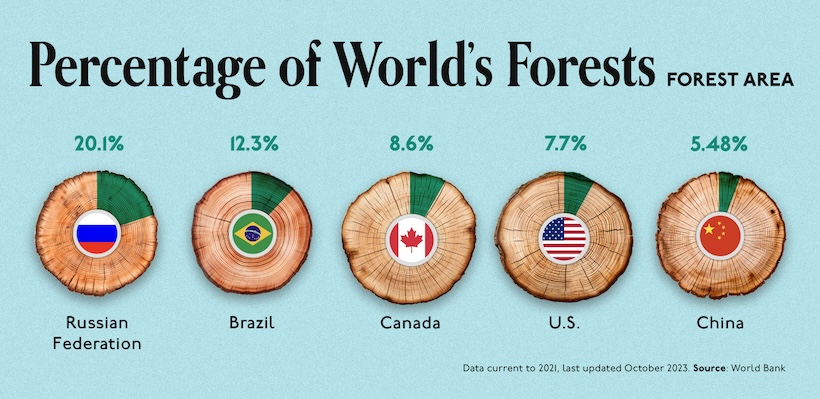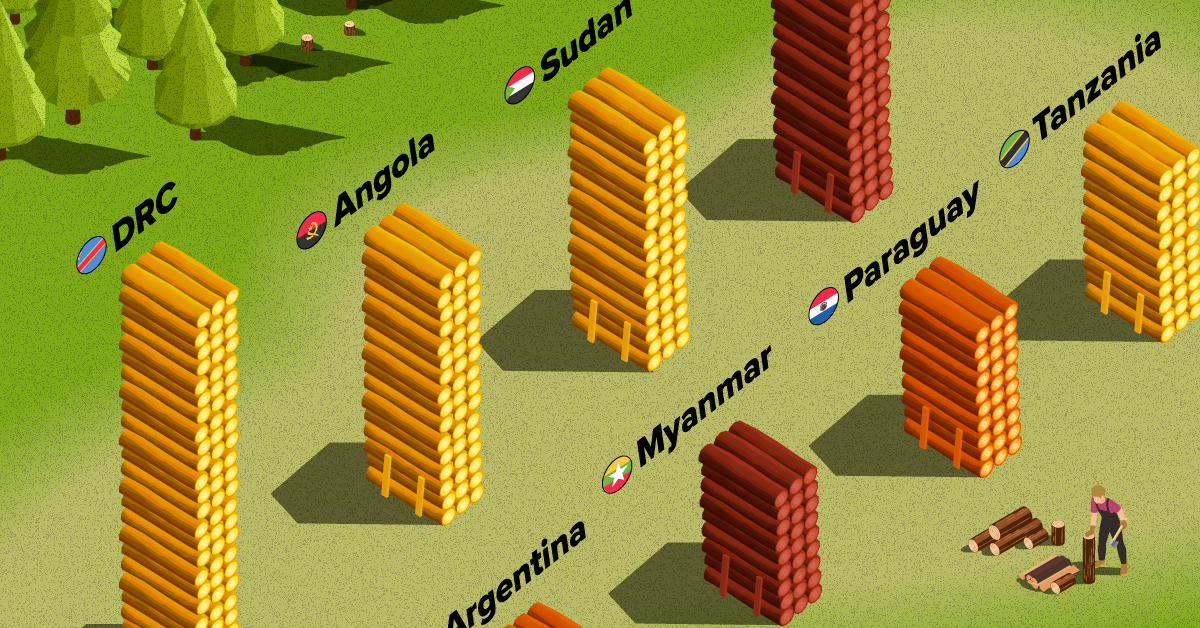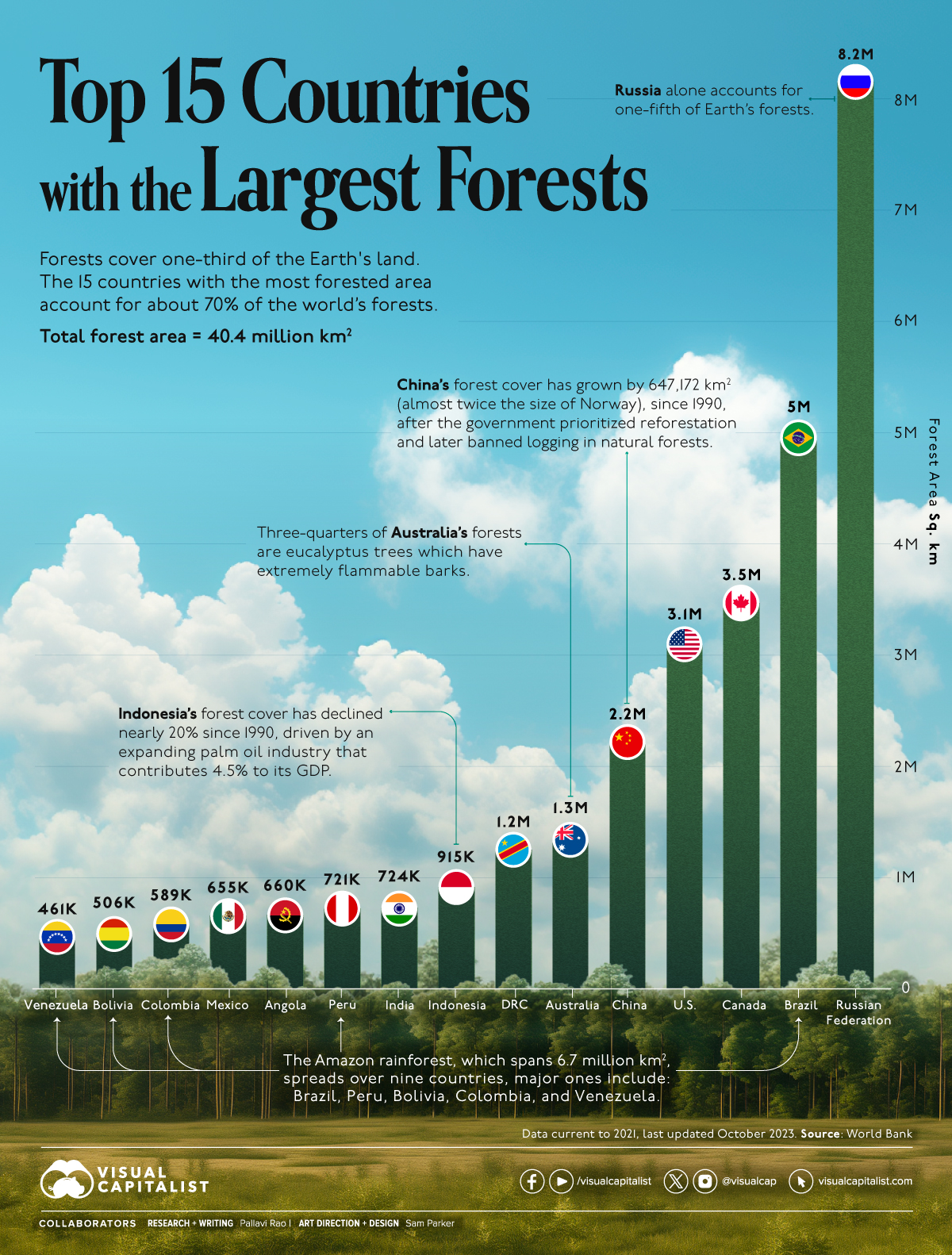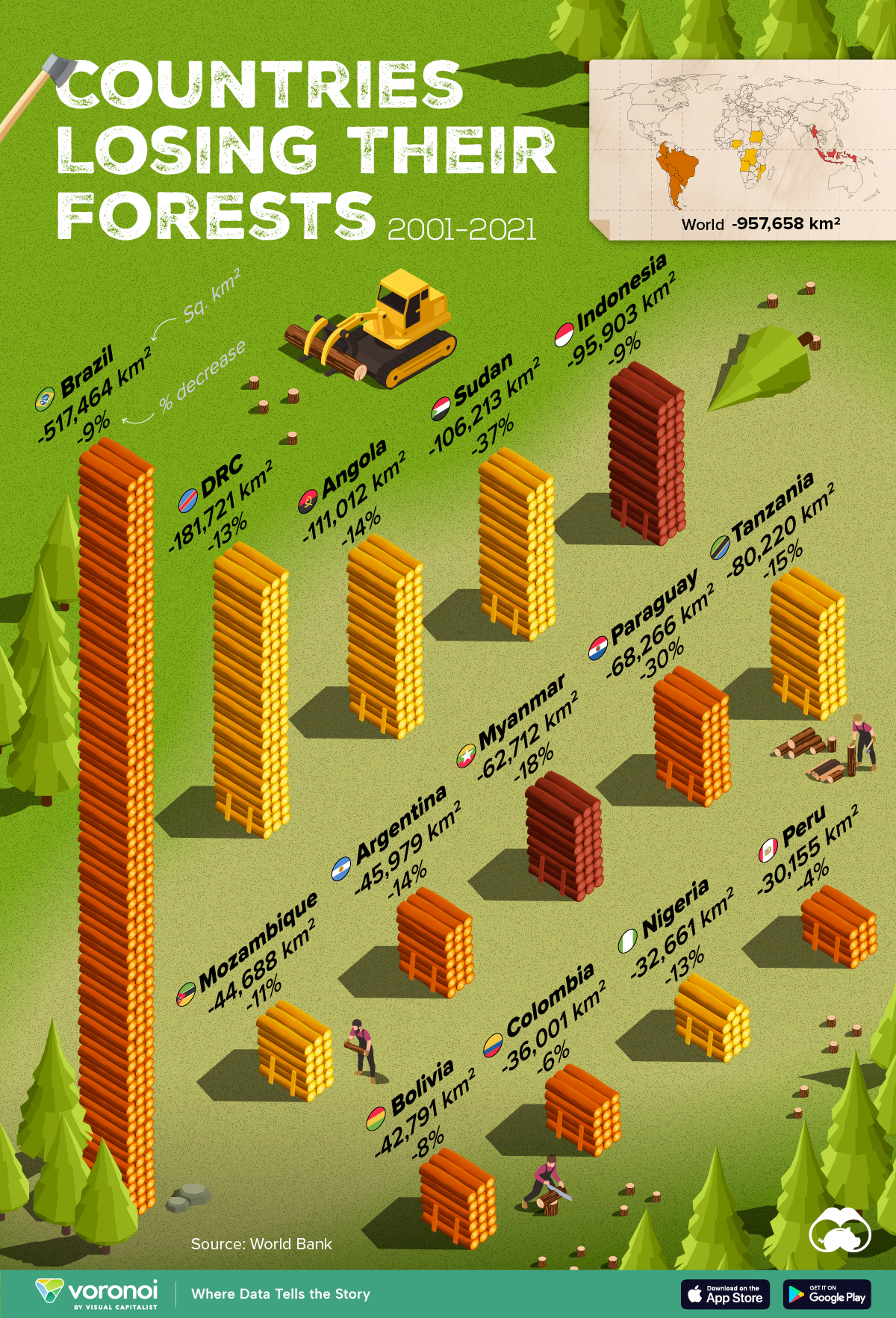Environment
Which Countries Have the Largest Forests?
![]() See this visualization first on the Voronoi app.
See this visualization first on the Voronoi app.
Which Countries Have the Largest Forests?
This was originally posted on our Voronoi app. Download the app for free on Apple or Android and discover incredible data-driven charts from a variety of trusted sources.
Since the last ice age, the Earth’s forest cover has fallen by 20 million km2 or 2 billion hectares. Half of the loss occurred since the year 1900 due to expanding agriculture and industrialization.
Now forests cover about 30% of the Earth’s land, about 40 million km2, distributed unevenly across the globe.
We visualize the top 15 countries with the largest forests, measured in square kilometers. Data for this visualization and article comes from the World Bank, using data for 2021 that was last updated in October 2023.
Ranked: Top 15 Countries with the Biggest Forests
Predictably, the largest country in the world also has the biggest forest area. Nearly 50% of Russia is forest, measuring roughly 8 million km2. This is bigger than the total land area of every other country in the world—with the exception of China, the U.S., Canada, Brazil, and Australia.
It also means one-fifth of the world’s entire forested area is in Russia.

Most of Russia’s forests are boreal, to survive the colder, drier climes in the country, and are made up of deciduous and coniferous tree species including larch, pine, spruce, and oak.
At second place, Brazil has nearly 5 million km2 of forest cover (about 12% of the world’s forests), thanks to almost two-thirds of the Amazon rainforest inside its borders. For context, Brazil’s forested area is almost twice the size of Saudi Arabia, the 12th largest country in the world.
| Rank | Country | Forest Area (Sq. km) | Forest Area (% of World's Forests) |
|---|---|---|---|
| 1 | 🇷🇺 Russia | 8,153,116 | 20.1% |
| 2 | 🇧🇷 Brazil | 4,953,914 | 12.3% |
| 3 | 🇨🇦 Canada | 3,468,911 | 8.6% |
| 4 | 🇺🇸 U.S. | 3,097,950 | 7.7% |
| 5 | 🇨🇳 China | 2,218,578 | 5.5% |
| 6 | 🇦🇺 Australia | 1,340,051 | 3.3% |
| 7 | 🇨🇩 DRC | 1,250,539 | 3.1% |
| 8 | 🇮🇩 Indonesia | 915,277 | 2.3% |
| 9 | 🇮🇳 India | 724,264 | 1.8% |
| 10 | 🇵🇪 Peru | 721,575 | 1.8% |
| 11 | 🇦🇴 Angola | 660,523 | 1.6% |
| 12 | 🇲🇽 Mexico | 655,643 | 1.6% |
| 13 | 🇨🇴 Colombia | 589,426 | 1.5% |
| 14 | 🇧🇴 Bolivia | 506,208 | 1.3% |
| 15 | 🇻🇪 Venezuela | 461,734 | 1.1% |
| 16 | 🇹🇿 Tanzania | 452,760 | 1.1% |
| 17 | 🇿🇲 Zambia | 446,258 | 1.1% |
| 18 | 🇲🇿 Mozambique | 364,976 | 0.9% |
| 19 | 🇵🇬 Papua New Guinea | 358,222 | 0.9% |
| 20 | 🇦🇷 Argentina | 284,637 | 0.7% |
The Amazon also contributes significantly to Peru’s forest cover (ranked 10th on this list) along with Colombia (13th) Bolivia (14th) and Venezuela (15th).
Canada and the U.S., rank third and fourth with roughly the same forest cover—3 million km2— with several forests on both coasts extending across their shared border.
China rounds out the top five, its forests covering slightly more than 2 million km2.
Together the top five countries account for more than half of the world’s forests.
When taking in the top 10, which adds in forest cover from Australia, the DRC, Indonesia, India, and Peru, this grows to slightly more than two-third’s of the world’s forests. Expanding the ranks to the top 20 will then accounts for 80% of the Earth’s total forest cover.
Natural Forests vs. Planted Forests
Not all forests are created equal. Primary forests—forests undisturbed by human activity—are better carbon sinks and have greater biodiversity than human-planted ones.
Here’s how each country’s forest cover is divided between primary and naturally-regenerating forests (forest where there are clearly visible indications of human activities but are now slowly reverting back to their natural state) and human–planted ones.
| Territory | Naturally Regenerating Forests | Planted Forests |
|---|---|---|
| 🇦🇫 Afghanistan | 100% | 0% |
| 🇦🇱 Albania | 90% | 10% |
| 🇩🇿 Algeria | 71% | 29% |
| 🇦🇸 American Samoa | 100% | 0% |
| 🇦🇩 Andorra | 100% | 0% |
| 🇦🇴 Angola | 99% | 1% |
| 🇦🇷 Argentina | 95% | 5% |
| 🇦🇲 Armenia | 94% | 6% |
| 🇦🇼 Aruba | 100% | 0% |
| 🇦🇺 Australia | 98% | 2% |
| 🇦🇹 Austria | 57% | 43% |
| 🇦🇿 Azerbaijan | 73% | 27% |
| 🇧🇸 Bahamas | 100% | 0% |
| 🇧🇭 Bahrain | 0% | 100% |
| 🇧🇩 Bangladesh | 92% | 8% |
| 🇧🇧 Barbados | 100% | 0% |
| 🇧🇾 Belarus | 75% | 25% |
| 🇧🇪 Belgium | 36% | 64% |
| 🇧🇿 Belize | 100% | 0% |
| 🇧🇯 Benin | 99% | 1% |
| 🇧🇹 Bhutan | 99% | 1% |
| 🇧🇴 Bolivia | 100% | 0% |
| 🇧🇶 Bonaire | 100% | 0% |
| 🇧🇦 Bosnia & Herzegovina | 94% | 6% |
| 🇧🇼 Botswana | 100% | 0% |
| 🇧🇷 Brazil | 98% | 2% |
| 🇧🇳 Brunei | 99% | 1% |
| 🇧🇬 Bulgaria | 80% | 20% |
| 🇧🇫 Burkina Faso | 97% | 3% |
| 🇧🇮 Burundi | 60% | 40% |
| 🇨🇻 Cabo Verde | 30% | 70% |
| 🇰🇭 Cambodia | 92% | 8% |
| 🇨🇲 Cameroon | 100% | 0% |
| 🇨🇦 Canada | 95% | 5% |
| 🇰🇾 Cayman Islands | 100% | 0% |
| 🇨🇫 Central African Republic | 100% | 0% |
| 🇹🇩 Chad | 100% | 0% |
| 🇨🇽 Channel Islands | 19% | 81% |
| 🇨🇱 Chile | 82% | 18% |
| 🇨🇳 China | 61% | 39% |
| 🇨🇴 Colombia | 99% | 1% |
| 🇰🇲 Comoros | 100% | 0% |
| 🇨🇬 Congo | 100% | 0% |
| 🇨🇰 Cook Islands | 93% | 7% |
| 🇨🇷 Costa Rica | 97% | 3% |
| 🇨🇮 Côte d'Ivoire | 99% | 1% |
| 🇭🇷 Croatia | 97% | 3% |
| 🇨🇺 Cuba | 84% | 16% |
| 🇨🇼 Curaçao | 100% | 0% |
| 🇨🇾 Cyprus | 81% | 19% |
| 🇨🇿 Czechia | 5% | 95% |
| 🇩🇰 Denmark | 36% | 64% |
| 🇩🇯 Djibouti | 95% | 5% |
| 🇩🇲 Dominica | 98% | 2% |
| 🇩🇴 Dominican Republic | 91% | 9% |
| 🇨🇩 DRC | 100% | 0% |
| 🇪🇨 Ecuador | 99% | 1% |
| 🇪🇬 Egypt | 0% | 100% |
| 🇸🇻 El Salvador | 97% | 3% |
| 🇬🇶 Equatorial Guinea | 95% | 5% |
| 🇪🇷 Eritrea | 96% | 4% |
| 🇪🇪 Estonia | 91% | 9% |
| 🇸🇿 Eswatini | 80% | 20% |
| 🇪🇹 Ethiopia | 93% | 7% |
| 🇫🇴 Faroe Islands | 0% | 100% |
| 🇫🇯 Fiji | 82% | 18% |
| 🇫🇮 Finland | 67% | 33% |
| 🇫🇷 France | 86% | 14% |
| 🇬🇫 French Guiana | 100% | 0% |
| 🇵🇫 French Polynesia | 94% | 6% |
| 🇬🇦 Gabon | 100% | 0% |
| 🇬🇲 Gambia | 99% | 1% |
| 🇬🇪 Georgia | 97% | 3% |
| 🇩🇪 Germany | 50% | 50% |
| 🇬🇭 Ghana | 96% | 4% |
| 🇬🇷 Greece | 96% | 4% |
| 🇬🇱 Greenland | 0% | 100% |
| 🇬🇩 Grenada | 99% | 1% |
| 🇬🇵 Guadeloupe | 99% | 1% |
| 🇬🇺 Guam | 100% | 0% |
| 🇬🇹 Guatemala | 96% | 4% |
| 🇬🇳 Guinea | 99% | 1% |
| 🇬🇼 Guinea-Bissau | 100% | 0% |
| 🇬🇾 Guyana | 100% | 0% |
| 🇭🇹 Haiti | 91% | 9% |
| 🇭🇳 Honduras | 100% | 0% |
| 🇭🇺 Hungary | 62% | 38% |
| 🇮🇸 Iceland | 23% | 77% |
| 🇮🇳 India | 82% | 18% |
| 🇮🇩 Indonesia | 95% | 5% |
| 🇮🇷 Iran | 91% | 9% |
| 🇮🇶 Iraq | 89% | 11% |
| 🇮🇪 Ireland | 14% | 86% |
| 🇮🇱 Israel | 39% | 61% |
| 🇮🇹 Italy | 93% | 7% |
| 🇯🇲 Jamaica | 99% | 1% |
| 🇯🇵 Japan | 59% | 41% |
| 🇯🇴 Jordan | 52% | 48% |
| 🇰🇿 Kazakhstan | 88% | 12% |
| 🇰🇪 Kenya | 96% | 4% |
| 🇰🇼 Kuwait | 0% | 100% |
| 🇰🇬 Kyrgyzstan | 82% | 18% |
| 🇱🇦 Laos | 89% | 11% |
| 🇱🇻 Latvia | 86% | 14% |
| 🇱🇧 Lebanon | 100% | 0% |
| 🇱🇸 Lesotho | 75% | 25% |
| 🇱🇷 Liberia | 100% | 0% |
| 🇱🇾 Libya | 0% | 100% |
| 🇱🇮 Liechtenstein | 91% | 9% |
| 🇱🇹 Lithuania | 72% | 28% |
| 🇱🇺 Luxembourg | 66% | 34% |
| 🇲🇬 Madagascar | 97% | 3% |
| 🇲🇼 Malawi | 97% | 3% |
| 🇲🇾 Malaysia | 91% | 9% |
| 🇲🇻 Maldives | 100% | 0% |
| 🇲🇱 Mali | 96% | 4% |
| 🇲🇹 Malta | 91% | 9% |
| 🇲🇭 Marshall Islands | 67% | 33% |
| 🇲🇶 Martinique | 95% | 5% |
| 🇲🇷 Mauritania | 85% | 15% |
| 🇲🇺 Mauritius | 54% | 46% |
| 🇾🇹 Mayotte | 96% | 4% |
| 🇲🇽 Mexico | 100% | 0% |
| 🇫🇲 Micronesia | 78% | 22% |
| 🇲🇩 Moldova | 43% | 57% |
| 🇲🇳 Mongolia | 100% | 0% |
| 🇲🇪 Montenegro | 99% | 1% |
| 🇲🇸 Montserrat | 100% | 0% |
| 🇲🇦 Morocco | 89% | 11% |
| 🇲🇿 Mozambique | 100% | 0% |
| 🇲🇲 Myanmar | 98% | 2% |
| 🇳🇦 Namibia | 100% | 0% |
| 🇳🇵 Nepal | 96% | 4% |
| 🇳🇱 Netherlands | 10% | 90% |
| 🇳🇨 New Caledonia | 99% | 1% |
| 🇳🇿 New Zealand | 79% | 21% |
| 🇳🇮 Nicaragua | 98% | 2% |
| 🇳🇪 Niger | 88% | 12% |
| 🇳🇬 Nigeria | 99% | 1% |
| 🇳🇺 Niue | 100% | 0% |
| 🇳🇫 Norfolk Island | 90% | 10% |
| 🇰🇵 North Korea | 84% | 16% |
| 🇲🇵 Northern Mariana Islands | 100% | 0% |
| 🇳🇴 Norway | 99% | 1% |
| 🇴🇲 Oman | 82% | 18% |
| 🇵🇰 Pakistan | 93% | 7% |
| 🇵🇦 Panama | 98% | 2% |
| 🇵🇬 Papua New Guinea | 100% | 0% |
| 🇵🇾 Paraguay | 99% | 1% |
| 🇵🇪 Peru | 98% | 2% |
| 🇵🇭 Philippines | 95% | 5% |
| 🇵🇱 Poland | 22% | 78% |
| 🇵🇹 Portugal | 32% | 68% |
| 🇵🇷 Puerto Rico | 100% | 0% |
| 🇷🇪 Réunion | 89% | 11% |
| 🇷🇴 Romania | 87% | 13% |
| 🇷🇺 Russia | 98% | 2% |
| 🇷🇼 Rwanda | 45% | 55% |
| 🇧🇱 Saint Barthélemy | 100% | 0% |
| 🇸🇭 Saint Helena | 100% | 0% |
| 🇱🇨 Saint Lucia | 85% | 15% |
| 🇫🇷 Saint Martin | 100% | 0% |
| 🇵🇲 Saint Pierre | 100% | 0% |
| 🇻🇨 Saint Vincent & the Grenadines | 99% | 1% |
| 🇼🇸 Samoa | 97% | 3% |
| 🇸🇲 San Marino | 100% | 0% |
| 🇸🇹 Sao Tome & Principe | 100% | 0% |
| 🇸🇦 Saudi Arabia | 100% | 0% |
| 🇸🇳 Senegal | 100% | 0% |
| 🇷🇸 Serbia | 96% | 4% |
| 🇸🇨 Seychelles | 85% | 15% |
| 🇸🇱 Sierra Leone | 99% | 1% |
| 🇸🇬 Singapore | 100% | 0% |
| 🇸🇽 Sint Maarten | 100% | 0% |
| 🇸🇰 Slovakia | 61% | 39% |
| 🇸🇮 Slovenia | 96% | 4% |
| 🇸🇧 Solomon Islands | 99% | 1% |
| 🇸🇴 Somalia | 100% | 0% |
| 🇿🇦 South Africa | 82% | 18% |
| 🇰🇷 South Korea | 64% | 36% |
| 🇸🇸 South Sudan | 97% | 3% |
| 🇪🇸 Spain | 86% | 14% |
| 🇱🇰 Sri Lanka | 88% | 12% |
| 🇸🇩 Sudan | 99% | 1% |
| 🇸🇷 Suriname | 100% | 0% |
| 🇸🇪 Sweden | 50% | 50% |
| 🇨🇭 Switzerland | 88% | 12% |
| 🇸🇾 Syrian | 59% | 41% |
| 🇹🇯 Tajikistan | 72% | 28% |
| 🇹🇿 Tanzania | 99% | 1% |
| 🇹🇭 Thailand | 82% | 18% |
| 🇹🇱 Timor-Leste | 100% | 0% |
| 🇹🇬 Togo | 95% | 5% |
| 🇹🇴 Tonga | 89% | 11% |
| 🇹🇹 Trinidad & Tobago | 65% | 35% |
| 🇹🇳 Tunisia | 69% | 31% |
| 🇹🇷 Türkiye | 97% | 3% |
| 🇹🇲 Turkmenistan | 100% | 0% |
| 🇹🇨 Turks & Caicos Islands | 100% | 0% |
| 🇹🇻 Tuvalu | 100% | 0% |
| 🇺🇸 U.S. | 91% | 9% |
| 🇺🇬 Uganda | 79% | 21% |
| 🇬🇧 UK | 11% | 89% |
| 🇺🇦 Ukraine | 50% | 50% |
| 🇺🇾 Uruguay | 41% | 59% |
| 🇺🇿 Uzbekistan | 38% | 62% |
| 🇻🇪 Venezuela | 97% | 3% |
| 🇻🇳 Viet Nam | 70% | 30% |
| 🇻🇮 Virgin Islands (U.S.) | 100% | 0% |
| 🇼🇫 Wallis & Futuna Islands | 89% | 11% |
| 🇪🇭 Western Sahara | 100% | 0% |
| 🇾🇪 Yemen | 100% | 0% |
| 🇿🇲 Zambia | 100% | 0% |
| 🇿🇼 Zimbabwe | 99% | 1% |
Source: Our World in Data.
In countries like Bahrain and Kuwait, areas of extreme aridity, where forests would not occur naturally, human-planted forests account for all forest cover.
But even across large parts of Europe, planted forests vastly outnumber primary and naturally-regenerated ones, indicating how much deforestation occurred on the continent in the last three centuries, which is now being steadily reversed.
In China, which increased its forest cover by the size of Norway in the last three decades, nearly 40% of the total forested area is planted.
Experts say that reversing forest degradation and protecting primary forests—holders of an incredible amount of carbon that would be released into the atmosphere when logged—should be prioritized instead of just planting new forests.
Green
Ranked: Top Countries by Total Forest Loss Since 2001
The country with the most forest loss since 2001 lost as much forest cover as the next four countries combined.

Ranked: Top Countries By Total Forest Loss Since 2001
This was originally posted on our Voronoi app. Download the app for free on iOS or Android and discover incredible data-driven charts from a variety of trusted sources.
Forests are critical natural resources, often caught in the crosshairs of economic development. Thanks to expanding human settlement, agriculture, and industry, the world lost nearly 1 million square kilometers (km²) of forest cover since 2001.
But where has most of this deforestation occurred?
We rank the countries by the total decrease in their forest area between 2001 and 2021, measured in square kilometers along with their percentage decrease for context. All of this data was sourced from the World Bank.
A caveat to this data: countries are ranked by total forest loss, so countries with the largest forests feature predominantly on this list.
Which Country Has Lost the Most Forests (2001-2021)?
Brazil has lost more than half a million square kilometers of forest in the last two decades. Agricultural expansion for beef and soy production alongside mining and infrastructure growth are the primary drivers behind this large scale deforestation.
This has also caused periodic fires in the Amazon rainforest, drawing repeated alarm from around the world. In fact, Brazil has lost as much forest cover as the next four countries combined.
The table below lists the countries included in this graphic, as well as several others further down the ranking.
| Rank | Country | Region | 2001–21 Change (in km2) | % of Forest Loss |
|---|---|---|---|---|
| 1 | 🇧🇷 Brazil | South America | -517,464 | -9% |
| 2 | 🇨🇩 DRC | Africa | -181,721 | -13% |
| 3 | 🇦🇴 Angola | Africa | -111,012 | -14% |
| 4 | 🇸🇩 Sudan | Africa | -106,213 | -37% |
| 5 | 🇮🇩 Indonesia | Asia | -95,903 | -9% |
| 6 | 🇹🇿 Tanzania | Africa | -80,220 | -15% |
| 7 | 🇵🇾 Paraguay | South America | -68,266 | -30% |
| 8 | 🇲🇲 Myanmar | Asia | -62,712 | -18% |
| 9 | 🇦🇷 Argentina | South America | -45,979 | -14% |
| 10 | 🇲🇿 Mozambique | Africa | -44,688 | -11% |
| 11 | 🇧🇴 Bolivia | South America | -42,791 | -8% |
| 12 | 🇨🇴 Colombia | South America | -36,001 | -6% |
| 13 | 🇳🇬 Nigeria | Africa | -32,661 | -13% |
| 14 | 🇵🇪 Peru | South America | -30,155 | -4% |
| 15 | 🇰🇭 Cambodia | Asia | -28,491 | -26% |
| 16 | 🇻🇪 Venezuela | South America | -28,130 | -6% |
| 17 | 🇲🇽 Mexico | North America | -26,732 | -4% |
| 18 | 🇿🇲 Zambia | Africa | -23,924 | -5% |
| 19 | 🇧🇼 Botswana | Africa | -23,660 | -14% |
| 20 | 🇨🇮 Cote d'Ivoire | Africa | -22,577 | -45% |
What is quickly apparent is how most of the countries on this list are from Africa and South America. A study found a correlation where developing economies tend to have higher deforestation rates than advanced economies. Former colonies have also experienced more forest loss than those that were not colonized.
In Asia, Indonesia’s burgeoning palm oil industry is a key driver to deforestation, though efforts are now being made to reverse its impact. Meanwhile, Cambodia experienced rapid clear-cutting for its growing rubber plantations and timber industry.
Finally, Myanmar has long contended with illegal logging, but the country’s ongoing civil war is styming conversation efforts.
-

 Debt1 week ago
Debt1 week agoHow Debt-to-GDP Ratios Have Changed Since 2000
-

 Markets2 weeks ago
Markets2 weeks agoRanked: The World’s Top Flight Routes, by Revenue
-

 Countries2 weeks ago
Countries2 weeks agoPopulation Projections: The World’s 6 Largest Countries in 2075
-

 Markets2 weeks ago
Markets2 weeks agoThe Top 10 States by Real GDP Growth in 2023
-

 Demographics2 weeks ago
Demographics2 weeks agoThe Smallest Gender Wage Gaps in OECD Countries
-

 United States2 weeks ago
United States2 weeks agoWhere U.S. Inflation Hit the Hardest in March 2024
-

 Green2 weeks ago
Green2 weeks agoTop Countries By Forest Growth Since 2001
-

 United States2 weeks ago
United States2 weeks agoRanked: The Largest U.S. Corporations by Number of Employees















